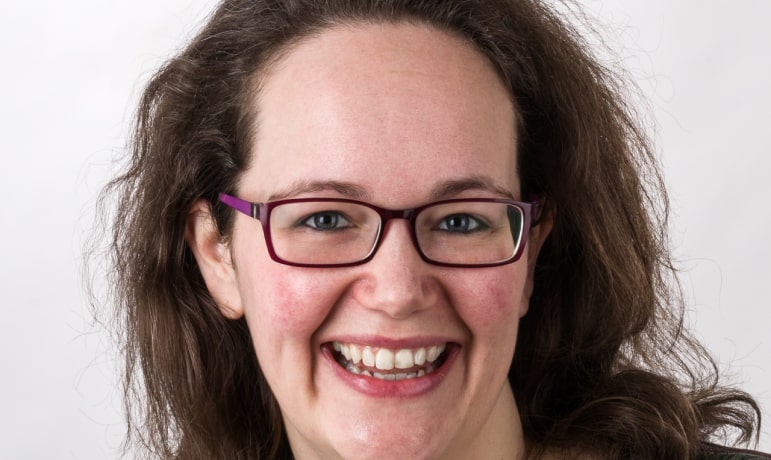‘Hospital consultations have become more focused and effective’
“Both the prevalence and incidence of Parkinson’s disease are on the rise, in part due to an aging population, while there are not necessarily more health care providers around; so you have to organize care in a different way.” For example, doctoral student Anke Wijers from Zuyderland Hospital summarizes the importance of Sanacoach Parkinson succinctly. She is conducting PhD research into the impact on the quality of care and the cost-effectiveness of this digital monitoring tool.
The immediate reason to talk to her about this tool is the recently launched National Implementation Study of Sanacoach Parkinson in five Dutch hospitals. The aim of the study: To determine the pros and cons of remote care for this case in detail. Wijers: “We hope to show that Sanacoach Parkinson can improve the quality of care while at the same time significantly reducing the number of physical appointments in the hospital.”
More responsibility
Sanacoach focuses on ‘patient empowerment’: informing the patient well of their illness, so they can handle it better and manage themselves more actively. “Patient complaints are followed up through periodic medical examination. This is a comprehensive questionnaire that you as a patient fill out once every three months. This takes about three-quarters of an hour.” The questionnaire results in a Likert scale score in 16 domains. Both the patient and the caregiver can see what is going well and what is less, and whether something is going better or worse than before. As a health care provider, you can also see how a change in medication has occurred, for example. “Suppose you start on anti-psychedelic medication, then you can just check on that aspect every week for a month to see how it’s going and if it’s effective,” says Wiggers. enough.” “And if there are new or increasing complaints, the program asks them again by default after six weeks, to see if they are permanent.” With a specific, practical, or care-related question, the patient does not have to wait to be able to fill out Questionnaire again: Through the program, the patient and the caregiver can send a message to each other directly.The application also contains a number of knowledge modules (so-called knowledge sessions) on issues such as response fluctuations, perception and some medications.
Less on poly, lower costs
The project has been under development for several years now. An article appeared in 2016 in medical contact About what was still called MyParkinsoncoach.1 Its developer, Sananet, recently changed its name to Sanacoach Parkinson, after similar applications for other diseases, such as Sanacoach IBD.
Wijers explains how she approached this topic: “I am a neurologist by training, but I am also very interested in organizing care. A few years ago, me and five others mapped out a future strategy for Züderland Hospital on a project. One important issue was how to systematically organize the care of chronic patients. Better. In this context, the cost-effectiveness of MijnParkinsoncoach had to be investigated. That’s what I started doing.”
A retrospective study showed that persons with disabilities visited an outpatient clinic by 29% and that health care costs decreased.2 Wijers: “I have now completed my PhD project from a large-scale prospective study in five peripheral hospitals to Sanacoach Parkinson. We have included about 130 patients, and hopefully there will be at least 250. I hope to be able to publish the results during 2025 “.
confrontation quests
So Wijers can’t provide the results of the study yet, but she already has a good impression of the appreciation of healthcare providers and patients. “Consultations in the hospital have become more focused and effective,” she says. “Patients come in with a specific complaint, which has often been discussed previously across the app; and patients who do well rarely or never come in, rather than coming every few months as the norm.” She also sees drawbacks: “The answers to quarterly questionnaires have to be read and interpreted, often by nurses. You sometimes hear that I didn’t choose the profession for that.”
Patients are generally satisfied. “They find the connection to the hospital very good and accessible. However, some find the questions very difficult. You should ask about all the possible symptoms and signs of Parkinson’s disease, even if it is not someone who has it. Not everyone wants to think about it every three months. Some find Also that 45 minutes for the questionnaire is very time consuming, although you can fill it out whenever you want.” Wijers adds: “This type of feedback allows us to constantly think about further improvements.”
References:
- Tissingh G, Hoff J, Jie LJ, et al. Remote monitoring improves Parkinson’s disease care. Medical contact. 2016; 71:21.
- Wijers A, Hochstenbach L, Tissingh G. Remote monitoring via questionnaires reduces outpatient healthcare consumption in Parkinson’s disease. Move Discord Clean Brac. 2021; 8: 1075-82.

“Total coffee specialist. Hardcore reader. Incurable music scholar. Web guru. Freelance troublemaker. Problem solver. Travel trailblazer.”







More Stories
GALA lacks a chapter on e-health
Weird beer can taste really good.
Planets contain much more water than previously thought